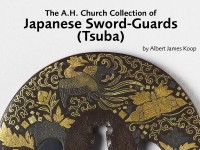The A. H. Church Collection of Japanese Sword-Guards (Tsuba)
An unpublished catalogue of the A. H. Church collection of Japanese sword-guards (tsuba) by Albert James Koop.

The schools of this warlike province owe their inception to the patronage of the local daimiō, Hosokawa Tadaoki (d. 1645), himself an amateur maker of guards. Amongst the workers summoned by him to Higo were Hirata [Japanese text] Hikozō and Nishigaki [Japanese text] Kanshirō, who early founded each a school [unrepresented in the collection]. Their following was outshone, however, by the Hayashi [Japanese text] or Kasuga [Japanese text] group; other important Higo workers were the Kamiyoshi [Japanese text], the Shimidzu-Jingo [Japanese text], and, the Suwa [Japanese text]. Each of these schools adopted an individual style and affected unusual forms, especially for the mounts other than guards.
Flat piercing, often enriched with broad effects in gold or silver wire inlay, or else bold incrustation of brass or sentoku on Iron, as well as a marked originality, not to say eccentricity of design, are among the characteristics of Higo work. The riōhitsu are often of unusually large size and abnormal shape.
Kasuga-Hayashi
 Tsuba with karigane, or flying geese (EAX.10309)
Tsuba with karigane, or flying geese (EAX.10309)
 Tsuba with gosan-no-kiri, or paulownia leaves (EAX.10310)
Tsuba with gosan-no-kiri, or paulownia leaves (EAX.10310)
 Tsuba with blossoming plum branches (EAX.10311)
Tsuba with blossoming plum branches (EAX.10311)
Kamiyoshi
 Lenticular tsuba with Amida-yasurime, or radial striations (EAX.10313)
Lenticular tsuba with Amida-yasurime, or radial striations (EAX.10313)
 Tsuba with heraldic cherry blossoms (EAX.10314)
Tsuba with heraldic cherry blossoms (EAX.10314)
Shimidzu-Jingo
 Aori-shaped tsuba with an eagle (EAX.10315)
Aori-shaped tsuba with an eagle (EAX.10315)
 Mokkō-shaped tsuba with spider and cobweb (EAX.10316)
Mokkō-shaped tsuba with spider and cobweb (EAX.10316)
 Mokkō-shaped tsuba with petals or snow crystals (EAX.10316.a)
Mokkō-shaped tsuba with petals or snow crystals (EAX.10316.a)
Notice
Object information may not accurately reflect the actual contents of the original publication, since our online objects contain current information held in our collections database. Click on 'buy this publication' to purchase printed versions of our online publications, where available, or contact the Jameel Study Centre to arrange access to books on our collections that are now out of print.
© 2013 University of Oxford - Ashmolean Museum







